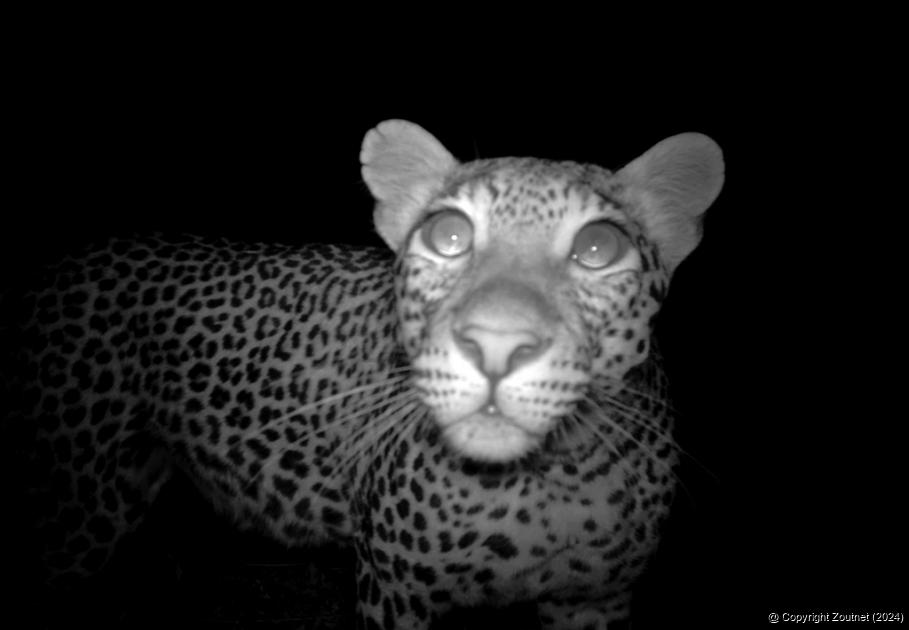

ADVERTISEMENT:

One of the Soutpansberg’s leopards, caught on camera at one of the research team’s 23 camera trap stations in their study area. Photo: Durham University.
Sharp decline due to illegal killings
Leopard populations in parts of South Africa are decreasing in greater numbers and at a greater speed than expected, due in large to the illegal killing by humans, new findings have shown.
Researchers from the department of anthropology, Durham University, in the United Kingdom (UK) conducted a long-term study of the leopard population in the Soutpansberg mountain and found that leopard density (the number of leopards per 100 km²) had decreased by 44% between 2012 and 2016 and by 66% since 2008.
The project, under guidance of Dr Samual Williams, aims to understand more about the threats these big cats are facing. The researchers hope that their findings, published in the academic journal Royal Society Open Science, will help inform conservation efforts.
Dr Williams explained the significance of the decrease they found. “If the current rate of decline is not slowed down, then there will be no leopards left in the western Soutpansberg mountains by 2020. This is especially alarming considering that in 2008 this area had one of the highest leopard population densities in Africa,” said Williams in a press release issued by the Durham University marketing and communications office.
The team set up 23 camera stations across the study area, running continuously from January 2012 until February 2016, to track leopard numbers. Individual leopards were identified by their unique coat markings allowing the researchers to build up the most detailed picture to date of leopard numbers in the area. The team also fitted eight adult leopards with GPS collars, tracking their movements for over a year to help understand why leopard numbers were declining.
Six of the eight leopards fitted with a tracking collar died during the period they were being monitored. Investigating the causes of death for the leopards, the team found that illegal killing of animals by humans, mainly in response to a perceived threat from leopards to livestock, was a leading cause. “Illegal human activities like shooting, snaring and poisoning were the leading cause of death in the leopards we tracked. This was often in response to a perception that leopards were a threat to livestock. There is a clear need for conservation efforts to address these illegal killings. Educating communities and supporting them to adopt non-lethal techniques to help protect their livestock is essential,” Dr Williams explained.
The team also argue that trophy hunting of leopards, which is subject to a temporary ban in South Africa whilst more data on leopard numbers is collected, should not be allowed to resume in areas such as the Soutpansberg Mountains, where numbers are in steep decline. “In areas such as this, trophy hunting is a luxury that cannot be afforded. Large carnivores like leopards are hugely important to the ecosystem of an area and also carry significant economic and cultural importance. Their loss would impoverish both the ecology of the area and human culture so it is vital that we understand the threats leopards face and act on this,” said Dr Williams.
The research was carried out by the Primate and Predator Project based at the Anthropology Field Station in the Soutpansberg Mountains. This is a wildlife research project, led by Professor Russell Hill from the department of anthropology at Durham University in the UK in conjunction with the Earthwatch Institute.
News - Date: 22 April 2017

Recent Articles
-

New Lukwarani leader may be blind, but has bright vision for his people
14 April 2024 By Elmon Tshikhudo -

Teach women to farm and they will change the world, says young farmer
14 April 2024 By Anton van Zyl -

-

Elim family fed-up with VDM's inability to fix sewer
13 April 2024 By Kaizer Nengovhela
Search for a story:

ADVERTISEMENT


Andries van Zyl
Andries joined the Zoutpansberger and Limpopo Mirror in April 1993 as a darkroom assistant. Within a couple of months he moved over to the production side of the newspaper and eventually doubled as a reporter. In 1995 he left the newspaper group and travelled overseas for a couple of months. In 1996, Andries rejoined the Zoutpansberger as a reporter. In August 2002, he was appointed as News Editor of the Zoutpansberger, a position he holds until today.
Email: [email protected]

ADVERTISEMENT:



